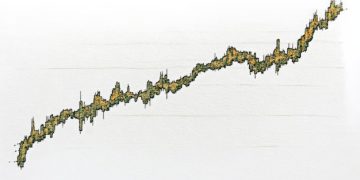Investing in Gold: Is It Really a Safe Haven?

Investing in gold is often considered a safe haven, especially
during economic uncertainties, due to its historical performance and perceived value as a store of wealth.
In times of economic turbulence, investors often seek a safe haven to protect their assets.
One such refuge that has stood the test of time is investing in gold. But is it really a
secure option in today’s complex financial landscape? Let’s explore the ins and outs of gold investments
and understand its role in a diversified portfolio.
Understanding Gold’s Appeal
Gold has captivated humanity for millennia, serving not only as a store of value but also as a symbol
of wealth and power. Its unique chemical properties make it resistant to corrosion and decay, contributing
to its longevity and desirability. But what makes gold so appealing as an investment, particularly in
uncertain times?
Historical Performance
Throughout history, gold has often maintained or even increased its value during periods of economic instability,
market crashes, and geopolitical crises. This perceived stability makes it an attractive option for investors
seeking to mitigate risk.
Intrinsic Value
Unlike fiat currencies, which are backed by governments, gold possesses intrinsic value. This means its
worth is derived from its inherent properties and scarcity, rather than the promises of a central authority.
- Physical scarcity contributes to its value.
- Global demand sustains its price.
- It is perceived as a hedge against inflation.
In essence, gold’s enduring appeal stems from its tangible nature and its historical ability to retain value
when other assets falter. This perception as a safe haven is what drives many investors to consider
including gold in their portfolios.
Different Ways to Invest in Gold
Investing in gold is not a one-size-fits-all approach. There are several avenues available, each with its
own set of advantages and disadvantages. Understanding the different options can help investors make informed
decisions that align with their financial goals and risk tolerance.

Physical Gold
This involves purchasing gold in its tangible form, such as coins, bars, or jewelry. Physical gold offers
direct ownership and can be a satisfying way to hold a piece of history. However, it also entails storage
costs, insurance fees, and potential security risks.
Gold ETFs
Exchange-Traded Funds (ETFs) that track the price of gold provide a convenient way to gain exposure to gold
without physically owning it. These funds are traded on stock exchanges and offer liquidity and diversification.
Gold Mining Stocks
Investing in companies that mine gold can be another option, but it comes with additional risks related to
the mining industry, such as operational challenges, regulatory issues, and environmental concerns.
- Gold ETFs offer liquidity and ease of trading.
- Physical gold provides direct ownership.
- Mining stocks can offer higher returns but come with increased risk.
The choice of how to invest in gold depends on individual preferences, investment objectives, and risk appetite.
Consider the pros and cons of each option before making a decision.
Gold as a Hedge Against Inflation
One of the most common arguments for investing in gold is its potential as a hedge against inflation. Inflation
erodes the purchasing power of fiat currencies, and gold is often viewed as a way to preserve wealth during
inflationary periods. But does gold really live up to this reputation?
Historical Correlation
Historically, gold prices have tended to rise during periods of high inflation. This is because investors
often turn to gold as an alternative store of value when the value of their currency is declining.
Limited Supply
The limited supply of gold, combined with increasing demand, can drive up its price during inflationary
times. This is in contrast to fiat currencies, which can be printed by central banks, potentially leading
to devaluation.
Although gold has historically performed well as an inflation hedge, its effectiveness can vary depending
on the specific economic conditions and the level of inflation. It’s essential to consider other factors,
such as interest rates and economic growth, when assessing gold’s potential as an inflation hedge.
The Role of Gold in Diversification
Diversification is a fundamental principle of sound investment management. Spreading investments across
different asset classes can help reduce risk and improve overall portfolio performance. Gold can play a
valuable role in a diversified portfolio, providing stability and potentially offsetting losses in other asset
classes.

Low Correlation
Gold often has a low or negative correlation with other asset classes, such as stocks and bonds. This means
that when these assets decline in value, gold may hold its own or even increase, providing a buffer against
losses.
Portfolio Stability
The inclusion of gold in a portfolio can reduce its overall volatility and improve its risk-adjusted returns.
This can be particularly beneficial for investors with a low risk tolerance or those approaching retirement.
- Gold’s low correlation with other assets enhances diversification.
- It can reduce portfolio volatility.
- It may improve risk-adjusted returns.
While the ideal allocation to gold will vary depending on individual circumstances, a small percentage of
gold can be a valuable addition to a well-diversified portfolio.
Factors Affecting Gold Prices
Gold prices are influenced by a complex interplay of factors, ranging from macroeconomic trends to geopolitical
events. Understanding these drivers can help investors make more informed decisions about when to buy, sell,
or hold gold.
Interest Rates
Interest rates have an inverse relationship with gold prices. When interest rates rise, the opportunity cost
of holding gold increases, as investors can earn a higher return on interest-bearing assets. This can lead
to a decrease in gold prices.
Currency Fluctuations
Changes in currency values can also impact gold prices. A weaker dollar, for example, can make gold more
attractive to foreign investors, driving up demand and prices.
Geopolitical Risks
Political instability, conflicts, and other geopolitical events can create uncertainty and fear in the markets.
In such times, investors often flock to gold as a safe haven, pushing up its price.
Monitoring these factors can provide valuable insights into the potential direction of gold prices, but it’s
important to remember that the market is dynamic and unpredictable.
Risks and Challenges of Investing in Gold
While gold offers potential benefits as a safe haven and a hedge against inflation, it’s not without its
risks and challenges. Investors need to be aware of these potential drawbacks before adding gold to their
portfolios.
Volatility
Gold prices can be volatile, especially in the short term. This means that investors may experience significant
gains and losses in a relatively short period of time. While gold provides relative stability in uncertain times, it is still volatile and may fluctuate based on market sentiment and other macroeconomic conditions.
Lack of Income
Unlike stocks or bonds, gold does not generate income. This means that investors rely solely on price
appreciation for their returns. The lack of income is a major drawback for many income investors.
Storage and Security
Storing physical gold can be costly and risky. Investors need to pay for secure storage facilities and
insurance to protect their gold from theft or damage.
Understanding these risks and challenges is crucial for making informed investment decisions and managing
expectations.
| Key Point | Brief Description |
|---|---|
| 🛡️ Safe Haven | Gold often maintains or increases value during economic downturns. |
| 💵 Inflation Hedge | Gold can preserve wealth when inflation decreases currency value. |
| 📈 Diversification | Gold has low correlation with other assets, reducing portfolio volatility. |
| ⚠️ Risks | Volatility, no income generation, and storage costs are potential drawbacks. |
Frequently Asked Questions
▼
Gold can be a part of a diversified portfolio for beginners, offering stability. However, it’s crucial to understand the risks and consider other investment options as well.
▼
Generally, gold prices tend to rise during periods of high inflation as investors seek a store of value. However, its effectiveness can vary.
▼
Risks include tracking errors, counterparty risk, and management fees. Understanding the ETF’s structure and investment strategy is essential.
▼
Consider secure storage facilities, bank vaults, or a home safe. Ensure your gold is insured against theft or damage, and keep the location well-protected.
▼
A common recommendation is to allocate 5-10% of your portfolio to gold. But, vary your allocation depending on your risk tolerance, financial goals, and economic outlook.
Conclusion
Investing in gold can be a strategic move in uncertain times, offering a potential safe haven and a hedge
against inflation. However, it’s essential to understand the different ways to invest, the factors that
influence gold prices, and the associated risks. By carefully considering these aspects, investors can
make informed decisions and integrate gold effectively into their portfolios.





